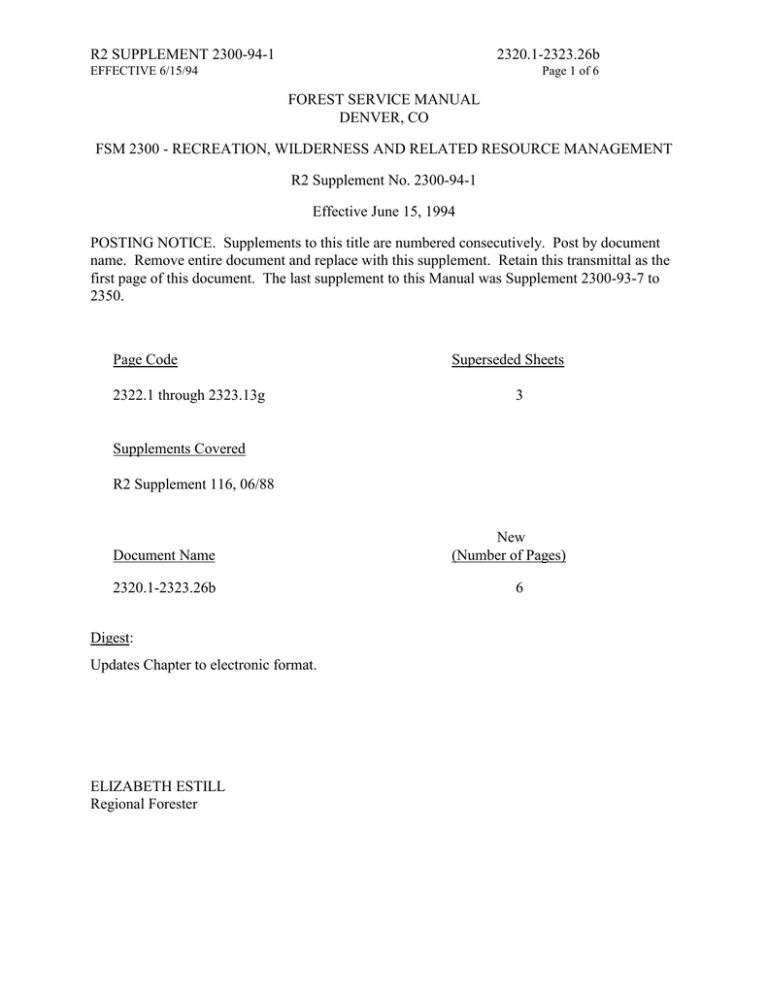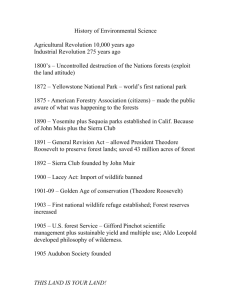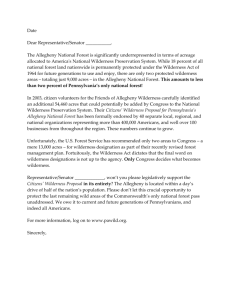R2 SUPPLEMENT 2300-94-1 2320.1-2323.26b FOREST SERVICE MANUAL DENVER, CO
advertisement

R2 SUPPLEMENT 2300-94-1 2320.1-2323.26b EFFECTIVE 6/15/94 Page 1 of 6 FOREST SERVICE MANUAL DENVER, CO FSM 2300 - RECREATION, WILDERNESS AND RELATED RESOURCE MANAGEMENT R2 Supplement No. 2300-94-1 Effective June 15, 1994 POSTING NOTICE. Supplements to this title are numbered consecutively. Post by document name. Remove entire document and replace with this supplement. Retain this transmittal as the first page of this document. The last supplement to this Manual was Supplement 2300-93-7 to 2350. Page Code 2322.1 through 2323.13g Superseded Sheets 3 Supplements Covered R2 Supplement 116, 06/88 Document Name 2320.1-2323.26b Digest: Updates Chapter to electronic format. ELIZABETH ESTILL Regional Forester New (Number of Pages) 6 R2 SUPPLEMENT 2300-94-1 EFFECTIVE 6/15/94 2320.1-2323.26b Page 2 of 6 TITLE 2300 - RECREATION, WILDERNESS, AND RELATED RESOURCE MANAGEMENT 2320 - WILDERNESS MANAGEMENT. 2322.1 - Wilderness Implementation Schedules. Implementation scheduling is the process of identifying, analyzing, and selecting activities and/or projects to implement the Forest Plan. The schedule will be for at least 3 years and be incorporated as an amendment to the Forest Plan. Forest Supervisors shall annually evaluate the schedule and update it as necessary. The Wilderness Implementation Schedule will be displayed as a table which includes a generalized priority for accomplishment, description of the action and its location, target date for completion and the unit and/or position responsible for completing the action. See Sample A. The table may include other optional entries such as estimated cost, output, revenue, etc. All process documentation leading up to the Schedule will be retained in the respective Wilderness case folder file (2320) and is not a part of the Forest Plan amendment. Activity (or project) identification will occur through an integrated area wide analysis process. Generally, the area will be an individual wilderness, plus areas adjacent to it that have a direct relationship with it, such as access points to the wilderness. The area analysis process is not development of another "plan". It is an assimilation of current issues and site-specific data to produce additional information for activity (or project) implementation. The objective is to select a cost efficient set of activities to change the existing condition on a wilderness to the planned condition identified in the Forest Plan. The following steps will generally be needed to complete the analysis and Schedule. 1. Coordinate analysis with all Forests and Districts responsible for administering the area. The Schedule will be for the total wilderness. The "lead" responsibility for wildernesses encompassing more than one National Forest is the same as for the Forest Plan. 2. Keep the public fully informed and involved. Use the NEPA scoping process to determine significant issues, concerns, and other information about the area and the activities being considered. At the outset, permittees (grazing, SU, etc.) right holders (private land, valid mining claims, etc.), and wilderness advocate organizations and individuals will be notified of the pending process. During scoping it is essential to have person-to-person contact with those likely to be affected by our actions. Public involvement is an on-going process throughout the activity identification analysis and execution. 3. Use an interdisciplinary approach. Wilderness is not the "domain" of the recreation specialists. Values and understanding embodied in many disciplines are needed in order to administer wilderness for the "... use and enjoyment of the American people in such manner as will leave them unimpaired for future use and enjoyment as wilderness, and so as to provide for the protection of these areas, the preservation of their wilderness character, and for the gathering and dissemination of information regarding their use and enjoyment as wilderness...." (Wilderness Act of 1964) 4. Compare existing versus planned conditions. From this comparison the ID Team identifies the management direction, standards and guidelines that are most in need of correcting. These will become the management concerns for the process and will provide the impetus for identifying activities and projects. Primary Forest Plan factors that may need to be reviewed are: R2 SUPPLEMENT 2300-94-1 EFFECTIVE 6/15/94 2320.1-2323.26b Page 3 of 6 * Air quality (nQRV). * Carrying capacity - outfitted/nonoutfitted use, use patterns, user conflicts, dogs, group size, opportunities for solitude. * Recreation Impacts - campsite condition, trail conditions, etc. * Cultural resources. * Educational and information program for users. * Ecosystem Maintenance. Fire management. Insect and disease. Forage use - livestock and transportation stock, noxious weeds, facility maintenance, Fish and wildlife - research, facilities, T&E species, population sampling, chemical treatment, spawn taking, fish planting, stocking, transplanting, aerial stocking, control of problem animals, visitor management to protect wildlife. * Land ownership adjustment. * Law enforcement. * Monitoring requirements in Forest Plan. * Regulations - 36 CFR 261.5. * Restoration - soil disturbance. * Signing. * Structures and Facilities - maintenance or removal. * Transportation system - maintenance, construction, reconstruction, access to private right locations, bridges. * Trailheads and access. * Volunteer program. * Water quality. Few, if any, Implementation Schedules deal with all these factors. Conversely, there may be factors not listed here that need consideration. (See Forest Plan, Forest Direction B02, Management Area Prescriptions 08A, 08B, 08C, and 08D) In some instances additional data may be needed to compare existing and planned conditions. If significant funding and time are needed for data collection, that in itself may be an activity identified in the Schedule. 5. Identify potential activities. This step is to identify potential activities or projects needed to reach or maintain the planned condition rather than select the final activity. 6. Analyze effects and develop Schedule activities. The analysis estimates the effects and feasibility of activities (or projects) against the planned condition, resolution of issues and the potential planned conditions. The activities should be staffed out until they are implementable and feasible. They are then listed on the Wilderness Implementation Schedule with priorities, based upon potential funding availability in out-years. General priorities are suggested, such as first, second and third so limited funds can be allocated to the most important activities. 7. Determine NEPA disclosure. Many of the activities, and in some cases the whole Schedule, may have effects which were disclosed in the Forest Plan EIS or the effects may be categorically excluded from documentation because they are not significant. For other activities documentation in an environmental assessment (EA) may be needed to determine significance. 8. Other Schedules. Any trail construction and/or reconstruction projects identified on the Wilderness Implementation Schedule should be carried forward to the Forest Plan Trail Implementation Schedule. R2 SUPPLEMENT 2300-94-1 EFFECTIVE 6/15/94 2320.1-2323.26b Page 4 of 6 9. Annual and/or Program Budget. The Implementation Schedule is used to develop the annual Program Budget. Including the estimated cost in the Schedule is optional, but, cost determination would obviously be accomplished in the analysis leading up to it. The estimated costs need to be carried forward into the Annual and/or Program Budgeting documents used on the respective Forest(s). R2 SUPPLEMENT 2300-94-1 2320.1-2323.26b EFFECTIVE 6/15/94 Page 5 of 6 SAMPLE A PAGE 1 OF 5 WILDERNESS IMPLEMENTATION SCHEDULE Snag Mountain PRIORITY WILDERNESS, ACTIONS (OR PROJECTS) AND LOCATION Wyoming NATIONAL FOREST(S), DATE 6-5-88 OPTIONAL ENTRIES RESPONSIBILITY TARGET FOR UNIT AND/OR ESTIMATED OUTPUTS REVENUE COMPLETION POSITION COST ($) RVD'S ($) 1 Inventory Big Red Lakes campsite density and conditions. Establish a schedule for an ongoing inventory system. Review campsite density against standards and guidelines for Forest direction 0628. Plan action for compliance. FY 89 District A 300 1 Close and rehabilitate sites in class 4 & 5 at Big Red Lakes FY 89 District A 500 2 Inventory String-of-Lakes travel zone campsite density and condition. Close and rehabilitae class 4 & 5 campsites. FY 90 Distirct B 500 1 Complete portal signing at; Shallow Creek trainhead Whimp Mountain trailhead Bushy ridge treailhead FY 89 FY 89 FY 89 District B District A District C 700 600 700 1 Maintain Visitor Registrys weekly at all sites with protal signing (Use volunteers) FY 89 All districts 2 Survey and mark boundary along east side of Section 35, T6N, R96E (Potential encroachment from adjacent private lands) FY 90 Forest Engineer 1700 2 Reanalyse Moose Meadow C&H allotment and update management plan. FY 91 Range Consv. District A 1000 3 Trail reconstruction on Shallow Creek trail between Red Creek and Tall Peak junction (2.3M) Planning Reconstruction FY 88 FY 89 District B District B FY 89 SO Rec Staff FY 88 FY 89 SO Lands Staff SO Lands Staff 1 Develop Snag Mountain Wilderness Brochure 2 Obtain ROW for Brushy Ridge Trail across Myers land. Appraisal & Negotiation Acquisition Ann. 500 400 26,000 350 1500 ? 2323.13g - Outfitter and Guide Operations. Outfitting and guide services may be permitted when compatible with the opportunities for solitude or primitive types of recreation and the use is within the assigned carrying capacity of the area. The type, number, and amount of recreation use that is allocated to outfitters should be determined during the environmental analysis process and should be based on the requirements in the Forest Plan.





